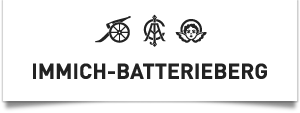The Vineyard
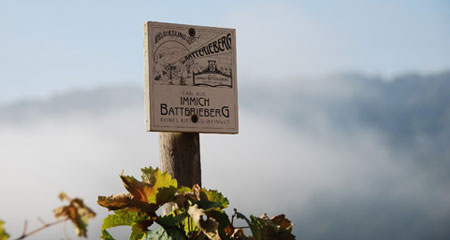
Batterieberg Weinberge
It is a unique backdrop for a cultural achievement which, perfectly interwoven with the natural landscape, evades in large part repetitiveness and which yields only with great resistance to the continual attention and character of its caretaker.
With that comes responsibility – first for the preservation of a singular cultural landscape and also for the use and the growth of the vineyards. A process, a journey of discovery, which is for us part of the estate’s core mission in the coming years.
Immich-Batterieberg works four vineyards on extremely steep slopes, all of which were included in the highest class in the Prussian Vineyard Classification of 1868 (based on Napoleon’s Classification des Vines from 1804). Ellergrub, Zeppwingert, and Batterieberg are to be found in a particularly quartzite-rich slate formation, the so-called „Starkenburg Slope“, located between Traben-Trarbach and Enkirch. More iron-rich is Steffensberg, which possesses one of the oldest kinds of vineyard demarcation – a pure south-facing slope behind the village of Enkirch itself.
Just as important to us as the inherent quality of the vineyards is the available grape material. We are delighted to have a very large portion of old, ungrafted vines, from which, because of their genetic diversity and their naturally low yields, the highly differentiated, deep, and site-typical Rieslings that we want can come into being.
The Wines
Estate wine – precise, fresh, elegant
CAI RIESLING Light with plenty of finesse and tension – our interpretation of a complex Riesling from mineral slate vineyards. A classic that only the Moselle can create!
DETONATION RIESLING A selection from the best Mosel vineyards produces an expressive, explosive, powerful and yet delicate Riesling. Surely a seafood companion!
Village Wines
ESCHEBURG RIESLING The essence of four top Enkirch vineyards, named after our estate building, gives this wine a lot of pressure and elegance from vines over 60 years old. Always a small Grand Cru!Premier Cru / Grand Cru
ENKIRCHER STEFFENSBERG RIESLING A pure south-facing site directly behind the center of Enkirch. These steep slate slopes are characterized by deep, copper-red soils with a very good supply of nutrients and water. The powerful but elegant wines open quickly and prove to be universal food companions.TRABENER ZOLLTURM RIESLING An old customs fortress on this extremely steep slope provides an imposing landmark for our latest vineyard acquisition. The monument of grey, quartzite-containing slate is only a few hundred meters away from the Ellergrub in Enkirch, but already belongs to the Traben-Trarbach region. An opulent, racy top-class Riesling that needs a lot of time.
ENKIRCHER ELLERGRUB RIESLING Our steepest and largest vineyard is located about 200 meters upstream of the Batterieberg in the Starkenburger Fels. Characterized by the finely eroded, dark (“blue”) slate, you will find the most subtle, finest and most elegant Riesling wines from our estate here. Always with a silky texture and invigorating clarity, they prove to be great long-distance runners.
ENKIRCHER BATTERIEBERG RIESLING The estate’s monopole vineyard is located in the Starkenburger Fels between Enkirch and Traben-Trarbach, surrounded by the Enkircher Zeppwingert. Characterized by rocky outcrops and old vineyard walls, this vineyard documents a piece of the Moselle’s vineyard history. Between 1841 and 1845, several rocky outcrops in the vineyard were broken up with the help of so-called blasting batteries in order to clear the land and improve cultivation. This unique location is characterized by grey slate with an unusually high proportion of quartzite. These Riesling wines are powerful, firm and multi-layered with a legendary longevity over many decades.
ENKIRCHER ZEPPWINGERT RIESLING In the Enkircher Zeppwingert, on dark gray slate, probably the oldest vines of the estate grow. The deep roots, which extend far into the soil, produce very firm, masculine Riesling wines with plenty of expression and a long shelf life. Regularly the source of our reserve wines!
The wine cellar
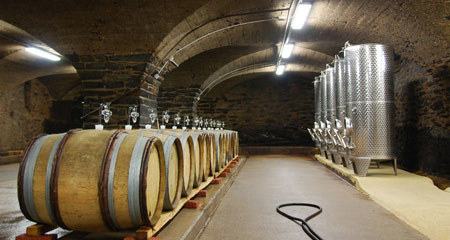
Kellerfässer und Stahl
What that means for us concretely is an even clearer orientation toward dry Riesling, a style long well-cultivated here, even when the rest of the area was committed to sweeter wines. We stand for a very pure, unadorned, and rather powerful style of Riesling, with ripe, moderate acidity and with the pronounced structure intended for a long aging potential – and also, of course, for a certain ripeness requirement, especially for our top wines.
Our wines are raised without a heavy hand, primarily in barrels (but also in stainless steel), and are left for a long time on their lees. We use no cultured yeast, no enzymes, no protein stabilizers, and no clarifying agents. We do not chaptalize, concentrate, or de-acidify and place ourselves in the tradition of natural wines that – until the 1971 reform of the German wine law – was indicated on the bottle by the phrase naturrein.
We stand for wines with a clear voice and a strong personality that reflect the special quality of Enkirch’s steep slate slopes, with their old vines and low yields, and which show – especially when consumed young – plenty of nooks and crannies and an (intentional) aversion to gloss.
Vintage
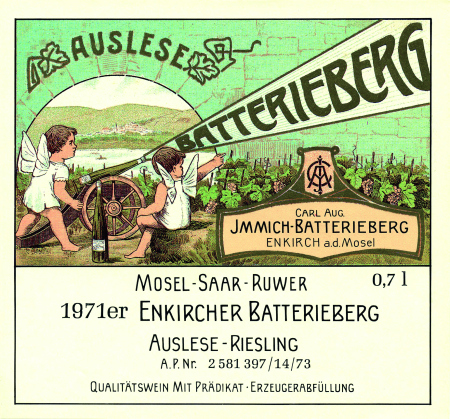
Batterieberg 1971
What vintage am I interested in today? Powerfully warming, playfully mineral-driven, or viscous and ripe? How are the 1998s showing? Or the 2003s? What about the 1973s?
For experienced wine lovers, the pleasure of the vintage game is second only to the wine itself. It is in the vintage that the heart of the wine beats. It decides the expression: lightness or weight, coolness or warmth, strength or softness, gracefulness or rusticity, transience or longevity. In all cases, these are subject to the conditions of site, grape variety, and winemaking methods!
In the vintage lies hidden the variation that separates artisanal wines from mass-produced wine, the curiosity that every year allows us to await with excitement the first must and then the first fully fermented wine, the pleasure of observing the changes as the wine ripens in the bottle. We have no interest in leveling out those differences, neither with regard to the contents, through technical attempts at manipulation (of course our wines are never chaptalized, concentrated or de-acidified) nor with information, by way of concealment of the vintage or minimization of the vintage’s influence.
Every year you will get wines from us which document the history of their creation and can tell us something of frost, heat, flowering, rain, harvest and decisions… We want to document our pleasure and our interest in authenticity and variation with a particularly notable representation of the vintage on our label. Each vintage has its own color, which we believe (fully aware of the limits of such associations) represents particularly well a given year’s character.
The history of the estate
According to archaeological estimates, the foundation of the building dates from the second half of the 9th century. Especially remarkable is the cellar’s load-bearing basalt pillar, which was „recycled‘ from a nearby Roman estate.
In the 12th Century the estate was ceded as a fief to Prince von Esch (hence to day’s Escheburg) and was then remodeled and expanded. The right wing of the property, the „Franzenhaus,‘ was not built until the 16th Century and the „Herrenhaus,‘ richly adorned in the Mosel-Frankish style and which today makes up the left wing, did not appear until the early 1900s.
It was the Immich family – among the oldest winemaking families on the Mosel, with a history that spans from 1425 through 1989 – that was especially crucial to the history and the development of the estate. We have them to thank for our most famous site, the Batterieberg, which between 1841 and 1845 was formed into one of the Mosel’s top sites by way of ceaseless rounds of dynamite. Batterieberg, along with the older top-tier sites Steffensberg, Ellergrub, and Zeppwingert, are all steep slate slopes and all achieved the highest ranking in the Prussian Vineyard Classification of 1868. Today they comprise the heart of the estate.
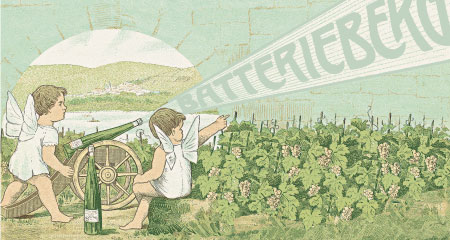
Batterieberg Etikett
The people in the winery

Philipp Clementi und Gernot Kollmann
In 2009 Gernot assumed responsibility for the direction and the winemaking at Weingut Immich-Batterieberg. He stands for a powerful, sometimes somewhat wild, „unstyled‘ style of Riesling (cultured yeasts are renounced for all wines), more on the dry side, and as a rule not intended for immediate consumption.
He is supported by Philipp Clementi, who comes from Senheim, downstream from the Moselle – he cultivates the extremely steep slopes of the vineyard with passion and expertise.
